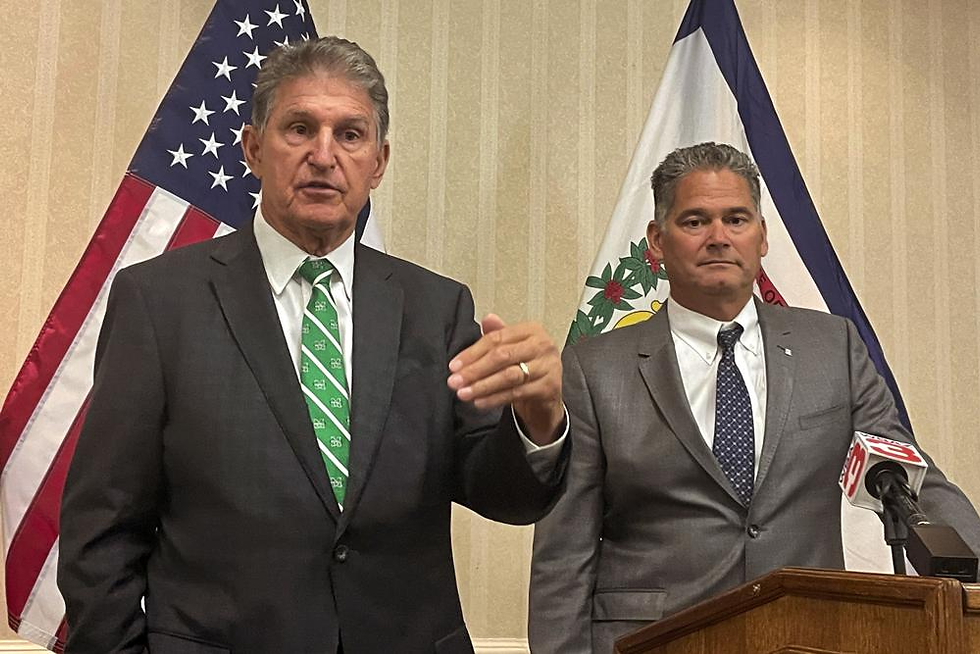After Climate Bill Passage, WV Natural Gas Plant Unveiled
- Mountaineer News

- Sep 17, 2022
- 4 min read
September 17, 2022
News Release | AP

U.S. Sen. Joe Manchin, a West Virginia Democrat, and Competitive Power Ventures CEO Gary Lambert, right, speak at a news conference Friday, Sept. 16, 2022, in Charleston, West Virginia. CPV plans to build a natural gas power plant designed to capture climate-changing carbon in West Virginia. (AP Photo/John Raby) CHARLESTON, WV - A Maryland company announced Friday it will build a natural gas power plant designed to capture climate-changing carbon in West Virginia. Officials said it was made possible by a recently signed law embraced by Democratic Sen. Joe Manchin that gives tax breaks for alternative energy projects.
Competitive Power Ventures of Silver Spring, Maryland, will construct the 1,800-megawatt plant using more than 1,000 union jobs. The natural gas used by the facility will support hundreds of additional jobs, the company said.
Manchin said at a news conference that it will be the first combined-cycle energy plant in West Virginia.
“We’re thrilled to welcome Competitive Power Ventures to the Mountain State,” he said.
Company CEO Gary Lambert said the energy produced will be used on the nation’s biggest electric grid, PJM Interconnection, serving 13 states and the District of Columbia.
The company said the extensive regulatory approval process has already started for the $3 billion project and it’s expected to go into operation later this decade. Lambert said the company is looking at several locations and hopes to select one this year.
President Joe Biden signed the legislation last month that will invest $375 billion to fight climate change over the next 10 years. In addition to addressing health care costs and prescription drug prices, it will direct spending, tax credits and loans to bolster technology like solar panels, consumer efforts to improve home energy efficiency, emission-reducing equipment for coal- and gas-powered power plants, and air pollution controls for farms, ports and low-income communities.
The signed measure is a slimmed-down version of a more ambitious plan that Biden and Democrats unveiled early last year but was deemed too costly by Manchin.
“The certainty that we now have for the next decade around the policies and the incentives to bring forward clean energy, that’s what CPV is about,” Lambert said. “We want to bring a portion of that wall of money to the state of West Virginia.”
Lambert called it “arguably the most significant legislation initiative we have seen in this country” since the Public Utility Regulatory Policies Act of 1978, which was passed in reaction to the nation’s energy crisis.
Some states are transitioning away from carbon dioxide-emitting fossil fuels to reduce greenhouse gas emissions and stave off the worst effects of a warming planet.
In late 2020, a study by researchers from the University of California, San Diego, found over 80% of 39 projects that have sought to commercialize carbon capture and storage ended in failure. The study cited lack of technological readiness as a top factor. Critics say carbon capture would require more energy to power the equipment, resulting in more air pollution because the technology can only catch a portion of the carbon emitted by a facility.
“Carbon capture has been done in a number of different industries, including the power industry,” Lambert said. He said the federal legislation requires that 70% of carbon emissions be captured. “We’re going to be closer to 90-95% capture here.”
West Virginia Gov. Jim Justice signed a bill earlier this year that established rules for companies using carbon sequestration.
“This is an outstanding day for West Virginia,” Justice said in the statement. “Competitive Power Ventures and the innovation they bring to the energy industry is amazing.”
CPV develops low-carbon electrical generation and conducts asset management services in the North American market. CPV is a subsidiary of Israel-based OPC Energy and was acquired in 2020.
CPV said it has combined gas and steam turbine projects in operation in Connecticut, Maryland, New Jersey, New York, and Pennsylvania, and a wind farm in western Oklahoma. Another combined-cycle facility is being built in northern Illinois, and solar power facilities are under development in Massachusetts and Pennsylvania.
Earlier this week, Justice announced that a firm owned by billionaire businessman Warren Buffett has partnered with the state to buy and develop more than 2,000 acres (800 hectares) in Ravenswood for a $500 million industrial park powered by renewable energy sources.
In addition, GreenPower Motor Co. Inc. recently began making electric school buses in South Charleston, while the energy startup SPARKZ said last month it will locate an electric battery factory near Bridgeport. In February, the Republican governor signed a bill eliminating the state’s 26-year-old ban on nuclear power plants.
West Virginia is the nation’s second-largest coal producer, behind Wyoming, and accounted for 5% of the nation’s total energy production in 2019, ranking fifth among the states, according to the U.S. Energy Information Administration. But West Virginia has lost thousands of coal jobs in the past decade as companies and utilities explore using other energy sources such as natural gas, solar and wind.
In 2020, coal-fired electric power plants accounted for 88% of West Virginia’s electricity generation. Renewable energy resources, primarily hydroelectric power and wind energy, contributed almost 6% and natural gas provided more than 3%.





Comments